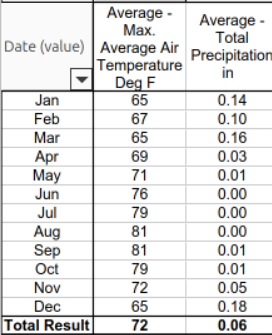I have several years worth of daily weather data. Some of the data is an average measurement from a given day (like the Max Avg Air Temp shown below) and some is the total measured during the day (like the Total Precipitation)

My ultimate goals are to:
- For each day of the year, know the AVERAGE value of both measurements over all years of available data
- For each month of the year, know: the AVERAGE of Daily Max Air Temps, but the monthly SUM of the daily precipitation totals, AVERAGED over all years of data
Some screenshots:
When I create a pivot table of the data, with the Date as rows and both measurements as columns and set the functions of each to AVERAGE, and group the date by “Daily”, things look correct:

However, when I change the grouping to “Monthly”, the Air Temp values are correct but the precipitation values show an average of the daily values for a given month over all years. I’d like for this value to show the sum of the daily precipitation values for each month, averaged over all years of data.

When I change the function of the Precipitation column to “Sum” instead of average, it shows the sum of the daily values of each month, but summed over all years of available data:

Attached is a file with the data. Thank you in advance!
file for forum question: monthly sum of daily measurements averaged over years.ods (66.6 KB)

